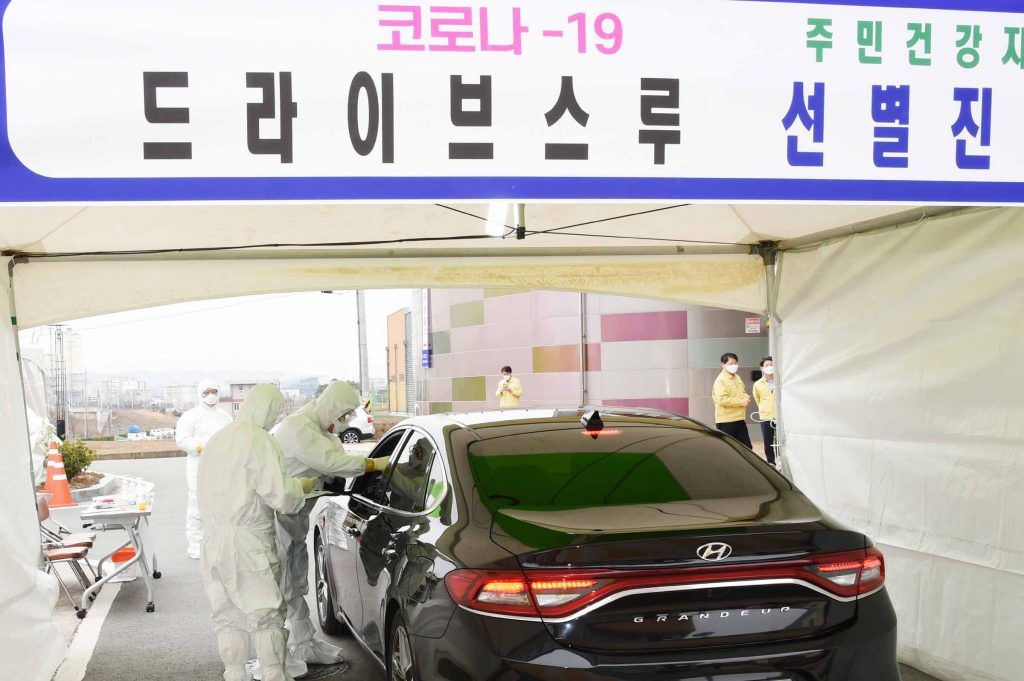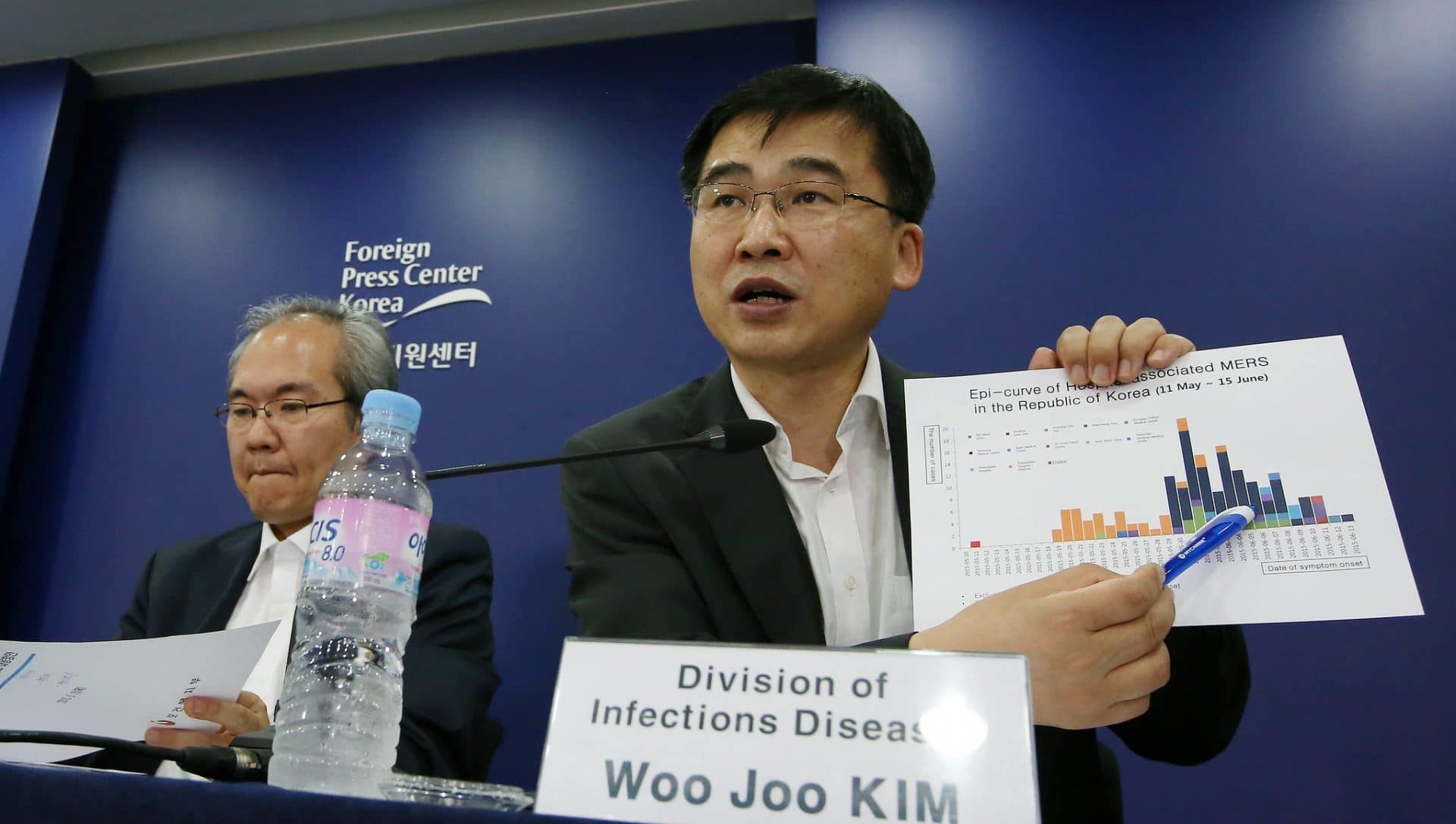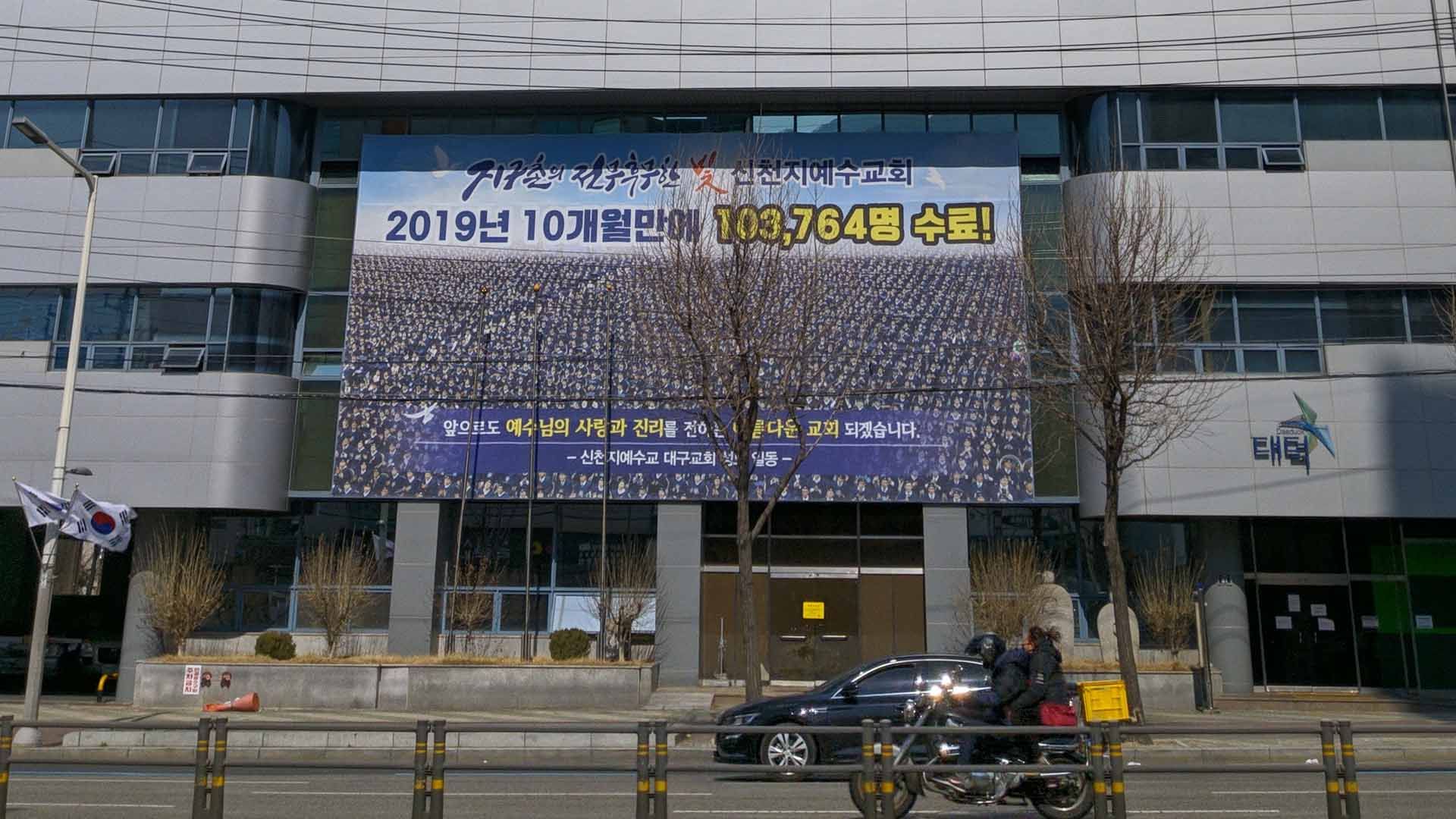South Korea learned its successful Covid-19 strategy from a previous coronavirus outbreak: MERS
By HyunJung Kim | March 20, 2020
 A drive-thru coronavirus testing facility in South Korea. Credit: Republic of Korea.
A drive-thru coronavirus testing facility in South Korea. Credit: Republic of Korea.
On Wednesday, the number of new coronavirus cases reported in South Korea fell to less than 100 for the fourth day in a row, a figure markedly down from the peak of 909 new cases reported on February 29. While there are signs that the Korean outbreak is starting to ebb, the United States, on the other hand, is only beginning to confront the true magnitude of the global pandemic. Each day, it seems, brings news of new closures, increasingly stringent guidance on social distancing, and new proposals to combat the outbreak and prop up the tanking economy. Amid an increasingly dire crisis, public health experts in the United States are citing Korea as a success story. “Do we want to go the direction of South Korea and really be aggressive and lower our mortality rates, or do we want to go the direction of Italy?” US Surgeon General Jerome Adams asked in a TV interview this week.
Korea’s response to Covid-19 is highlighting a strong public health approach to reigning in the outbreak, one that provides a lesson for the rest of the world. For the country’s health officials, however, it’s a lesson they learned the hard way. Korea’s traumatic experience with a 2015 outbreak of Middle East Respiratory Syndrome, or MERS, paved the way for many of the successful strategies the government is deploying this time around.
One coronavirus outbreak can teach a country and its government a lot about how to deal with another.
What happened in the MERS outbreak? On May 4, 2015, a 68-year-old man in the greenhouse business returned to Seoul after a 10-day business trip to Bahrain and other countries in the Middle East. A week later, feverish and in pain, the businessman visited several local clinics before being admitted with pneumonia to Pyeongtaek St. Mary’s Hospital, a secondary hospital in Gyeonggi Province. But when his condition didn’t improve there, he was transferred to Samsung Medical Center in Seoul, according to a 2018 article in the Korean Journal of Internal Medicine. While doctors at the large hospital finally diagnosed the businessman with MERS on May 20, it was already too late to stop the outbreak. By that point, he had spread the MERS coronavirus to 28 patients at the hospitals he’d visited before transferring to the medical center, according to a 2016 article in The Lancet.
In a stroke of bad fortune, a 35-year-old man who had been infected with the virus that causes MERS at Pyeongtaek St. Mary’s Hospital also ended up checking in at the Samsung Medical Center. Patient 14, as the 35-year-old is now called in the medical literature, visited the medical center’s emergency room on May 27. Two days later, doctors learned that he might have been infected by the businessman—another MERS patient, in the same facility, a mere nine days after the first patient had been diagnosed. Patient 14 was moved to an isolation room, but it was too late; he had already infected 82 others. As a result, South Korea suffered the largest outbreak of MERS outside of the Middle East, in total there were 186 confirmed cases, 38 people died and more than 16,000 were quarantined.
Lessons learned. Korean officials made mistakes that cost them precious time in the fight against MERS. One of those missteps amounted to nothing more than a data-entry lapse. At the time, the World Health Organization was providing information on the threat posed by MERS. While Bahrain didn’t have cases of MERS at the time, the organization listed it as having had outbreaks in the past. While other countries like the United States added Bahrain to the list of MERS danger zones, Korea did not. When the businessman sought medical treatment for flu-like symptoms, public health authorities ignored the possibility that he might have had MERS because he had come from Bahrain. Ministry of Health and Welfare officials rejected the request for a MERS test from the Samsung Medical Center, arguing that the businessman did not meet the criteria for a diagnosis.
Hospitals unwittingly became one of the major routes of transmission for the MERS outbreak in South Korea. For example, 85 of the 186 confirmed MERS cases in South Korea occurred among health care workers at the Samsung Medical Center. Hospitals were unprepared for the coronavirus to spread in their buildings. There were too few negative pressure isolation rooms, for instance. Additionally, Korean practices such as family nursing and doctor shopping created the perfect environment in hospitals for the MERS coronavirus to spread.
In Korea, a family member or a residential care worker hired by the family stays with the patient. Frequently, hospitals house four to six patients together per room. Rooms are always crowded with vulnerable patients, health care workers, and visiting families. And like the greenhouse businessman and Patient 14, Koreans often visit several hospitals as their symptoms warrant, instead of managing their health with a family doctor. The cumulative effect of these different health care practices contributed to the explosion of MERS in South Korea.

During the MERS outbreak, Koreans didn’t know who was infected and which hospitals had cases. Given the fact that MERS-CoV, the coronavirus that causes MERS, is often spread during a stay in hospital, public disclosure about the names of hospitals where infected people had visited or been admitted became a controversial issue among the public. The government did not release the information, not only because disclosure of patients’ private information could violate medical ethics, but also because officials feared economic fallout for hospitals and other private businesses that might have to shut down for decontamination. They believed that hospitals would reject diagnosing suspected infections for fear that they would be forced to close, which would only decrease the country’s medical capacity. Many people, however, demanded more transparency.
In particular, increased transparency was important to people with underlying diseases such as diabetes, who could avoid visiting hospitals that had experienced MERS cases. After the outbreak, public disclosure provisions were added to the Infectious Disease Control and Prevention Act, the legal framework for the Korea’s disease-prevention policy.
A second major lesson the South Korean government learned from its MERS outbreak was the importance of early warning and accurate diagnoses. The public health system missed a golden time for detecting the outbreak when the businessman visited different hospitals. While doctors were likely confused by his flu-like symptoms, the fact that Korean authorities had not updated the World Health Organization’s information to include Bahrain as posing a MERS risk could have compounded the matter.
Testing for MERS was also cumbersome, and doctors had to wait several days to confirm a case with a lab-based diagnostic. A newly developed MERS in-vitro diagnostic kit had not yet passed clinical trials and could not be used. Following the end of the MERS outbreak, South Korea enacted a new law in 2016 that allows laboratories to use unapproved in-vitro diagnostic kits in the case of a public health emergency.
South Korea and Covid-19. After news of the coronavirus outbreak began to emerge from Wuhan, China, earlier this year, the Korean government activated a 24/7 emergency response system to screen all travelers entering the country from that city. A woman was stopped at Incheon Airport en route for Japan at a fever monitoring station and transferred to a hospital where she was quarantined for 14 days. The Covid-19 diagnosis was confirmed on January 20. As it happens, that’s the same day the first US case was reported.
Since the first cases were confirmed, Korean public health authorities and local governments collaborated to precisely document the movement of infected people down to the minute. Authorities sought testimony, watched closed-circuit television, investigated smartphone GPS data and more, publicizing the so-called moving histories of Covid-19 patients. All local governments share information through websites, text messages, and media. Companies have developed apps that allow users to visualize the information. Koreans can now learn where infected people went, when they were there, and how they got there. If someone learns they might have been exposed, they can quickly visit a doctor and begin self-quarantine if they have similar symptoms.
On February 4, the Korea Centers for Disease Control and Prevention took advantage of the post-MERS reform and authorized an unlicensed Covid-19 test; the government went on to test an extraordinary number of people. By February 26, Korea had tested 46,127 cases, while by that point, Japan had tested just 1,846 cases and the United States only 426. Tests still remain hard to come by in the United States, despite the Trump administration’s repeated suggestions that widespread testing is imminent.

A second phase. Between January 20, and February 17, only 30 cases of Covid-19 were confirmed by the Korea Centers for Disease Control and Prevention. The country’s disease prevention efforts were working effectively. Then came February 18. A 31st case was reported in Daegu, the third-largest city in South Korea, a city of about 2.5 million in the country’s southeast. While in Daegu, Patient 31 attended services at the Shincheonji Church of Jesus, a Christian denomination, but one that is often accused of being a cult. Much like Patient 14 during the MERS outbreak five years prior, Patient 31 ended up spreading the new coronavirus to 14 people in the church. Covid-19 cases in Daegu skyrocketed. South Korea’s Ministry of Health and Welfare officially reported 3,150 total confirmed cases, including 17 deaths, as of February 29.
The public quickly turned its ire on the church’s secretive behaviors. For example, epidemic investigations confirmed that some cases were tied to a church mega-event held in Gwacheon city, Gyeonggi Province, on February 16. The church submitted a list to public health authorities of 1,290 members it said attended the event, but the governor of Gyeonggi Province revealed that the church’s disclosure was inaccurate.
An epidemic investigation team raided the church headquarters and obtained data showing that close to 10,000 members had actually attended the event. As of March 1, Korean authorities reported 3,526 confirmed cases and 93,459 suspected cases, and about 60 percent of the confirmed cases were tied to the church.
Lessons from COVID-19. The second phase of the Covid-19 outbreak revealed a loophole of South Korea’s public health emergency system: Although South Korea’s active search and diagnosis efforts have contributed to contain a chain reaction of the disease transmissions in the community, a single unsupportive person or group can disrupt the disease prevention efforts and ignite a massive outbreak. That’s a loophole that might be tough to close without active participation and support for social distancing by all citizens.
On March 13, a new coronavirus case was reported in Seongnam, a city close to Seoul. The public health authority reported that the new case was connected to the River of Grace Community Church. Despite of the government’s guideline for social distancing, the church held services on March 1 and March 8, and 46 people who attended the services were infected. The continuing infections at religious events are fueling an acrid public debate on whether the Korean government can restrict religious activities in the case of emergency. After all, freedom of religion is guaranteed in the Korean constitution.
South Korea has shown the world a path that democracies and more open countries might choose to follow, one that stands in contrast to the apparently effective but top-heavy approach that China employed. The question now is the same one as the US surgeon general posed: Will the world go in the direction of Korea?
Together, we make the world safer.
The Bulletin elevates expert voices above the noise. But as an independent nonprofit organization, our operations depend on the support of readers like you. Help us continue to deliver quality journalism that holds leaders accountable. Your support of our work at any level is important. In return, we promise our coverage will be understandable, influential, vigilant, solution-oriented, and fair-minded. Together we can make a difference.
Keywords: Coronavirus, Korea, MERS
Topics: Analysis, Technology and Security















